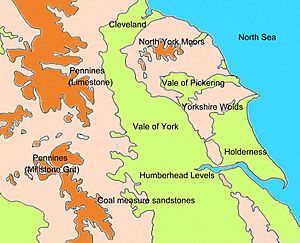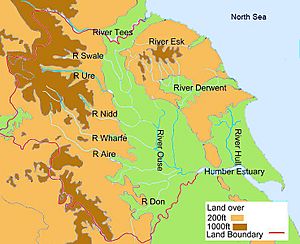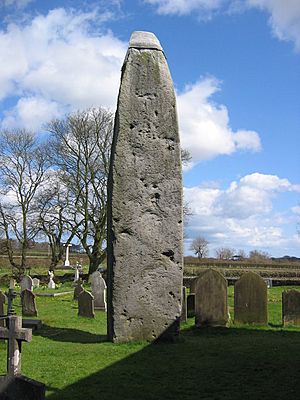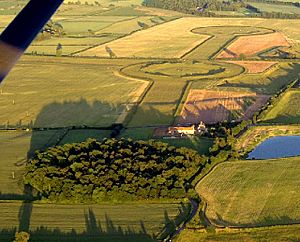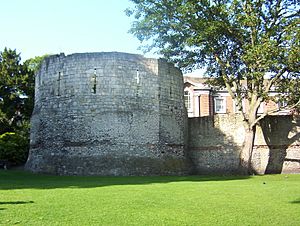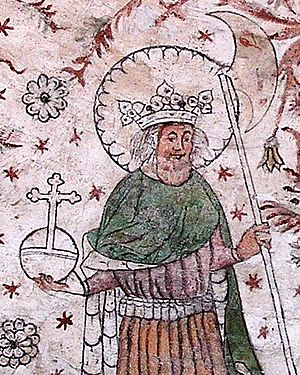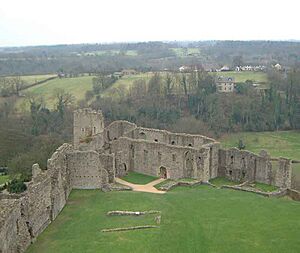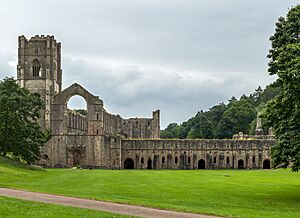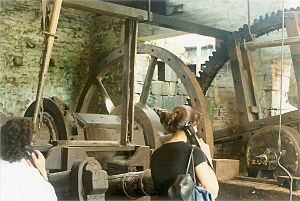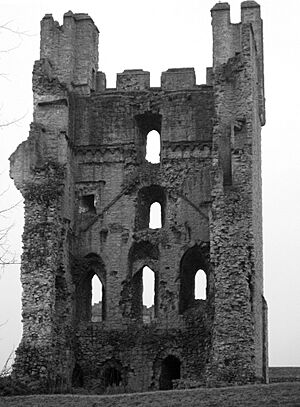History of Yorkshire facts for kids
Yorkshire is a special part of England with a long history. Its main city is York. People first lived here after the ice age ended, around 8000 BC. Over many centuries, different groups like the ancient Britons, Romans, Angles, and Vikings lived in and ruled the area.
The name "Yorkshire" comes from an old word "Eborakon" (around 150 AD), which probably meant "the place of the yew-trees." Many words and pronunciations in the Yorkshire dialect come from old Norse because of the Viking influence. The name "Yorkshire" first appeared in writing in the Anglo-Saxon Chronicle in 1065. It was originally split into three main areas called Thrydings, which later became known as Ridings.
After the Norman Conquest of England in 1066, Yorkshire faced a very difficult time called the harrying of the North. This event caused huge suffering. The area was also known for rebellions during the Tudor period. Later, during the industrial revolution, the West Riding became a very important place for making things in the United Kingdom. Meanwhile, the East and North Ridings mostly focused on fishing and farming. In more recent times, Yorkshire's economy changed as its traditional industries like coal, steel, wool, and shipping became less important.
Contents
Yorkshire's Landscape and Rivers
Yorkshire is not all the same. It has many different types of land and natural resources. These differences shaped how different parts of the county grew over time. For example, the North York Moors area is very different from the South Yorkshire Coalfield area in the West Riding, and that's also very different from Holderness.
The types of land in Yorkshire are closely linked to the rocks underneath. The Pennine hills in the west were formed during the Carboniferous period. The central valley has rocks from the Permian and Triassic periods. The North York Moors in the north-east have Jurassic rocks, while the Yorkshire Wolds to the south-east are made of Cretaceous chalk.
Many rivers flow through Yorkshire. In eastern and central Yorkshire, most rivers flow into the River Ouse, which then reaches the North Sea through the Humber Estuary.
The most northern river in the Ouse system is the Swale. It flows through Swaledale and Richmond. Next is the River Ure, which flows through Wensleydale and joins the Swale. The River Nidd starts in the Yorkshire Dales National Park and flows through Nidderdale before reaching the Vale of York.
The Ouse gets its name after the Ure joins it. The River Wharfe, which drains Wharfedale, also joins the Ouse. The Rivers Aire and Calder are further south and also flow into the River Ouse. The most southern river in Yorkshire that joins the Ouse is the River Don, which flows north to Goole. In the far north, the River Tees flows east through Teesdale and into the North Sea near Middlesbrough. The smaller River Esk flows from the west to the east at the foot of the North York Moors, reaching the sea at Whitby.
The River Derwent starts on the North York Moors, flows south and west through the Vale of Pickering, then turns south again to drain the eastern part of the Vale of York. It joins the River Ouse at Barmby on the Marsh. East of the Yorkshire Wolds, the River Hull flows south to join the Humber Estuary at Kingston upon Hull. The western Pennines are drained by the River Ribble, which flows west into the Irish Sea.
Ancient Times: Before the Romans Arrived
This period covers the time before the Romans came to this area, around 71 AD. The land looked very different back then. Early on, there was a land bridge connecting what is now Germany and eastern England. This allowed groups of hunters to walk into the area. When the first people arrived, the weather was very cold, like the Arctic. They hunted animals like mammoths, woolly rhinoceroses, and reindeer.
Evidence of human activity in Yorkshire from around 8000-7000 BC shows people lived as hunter gatherers. In Victoria Cave near Settle, ancient harpoon parts were found, dating back to about 8270 BC.
Over the next 5,000 years, the climate got warmer. Forests of birch, hazel, elm, pine, and oak trees grew. By 5000 BC, Britain became an island, separated from mainland Europe by rising sea levels. Chapel Cave near Malham might have been a hunting lookout during the Mesolithic period. Tools like small flint arrows and bones of animals like hare, fox, and deer were found there.
The Marsden area of the Pennines was also a seasonal hunting ground around 7000 BC. Stone Age tools have been found at Pule Hill and other nearby places.
On the North York Moors, many flint tools have been found from these early hunting and fishing communities. The oldest evidence of people in the Vale of Pickering is from around 7000 BC. The most important settlement from this time is Star Carr near Scarborough. Because the area was waterlogged, many ancient organic remains and flint tools survived. This is Britain's most famous Mesolithic site. People probably visited this village site, built on a platform of branches, to hunt, fish, gather plants, and make tools.
Near the Vale of Pickering, at West Heslerton, people have lived continuously since about 5000 BC. This site shows a lot about how people lived from the Neolithic period until today. Around 3000 BC, people started farming and raising animals. They built permanent homes and buried their dead in special mounds called barrows. These early farmers were the first to clear the forests on the North York Moors.
The Great Wold Valley also shows a lot about ancient people. It was an important place for worship. Four ancient pathways called cursus meet at Rudston village. The Rudston Monolith, over 25 feet tall, is the tallest standing stone in the United Kingdom. It's in the churchyard at Rudston and dates from the Late Neolithic Period.
The Thornborough Henges are a group of three large ancient circles near Thornborough. They are thought to have been part of a special "ritual landscape" during the Neolithic and Bronze Ages, from 3500 to 2500 BC. This place has been called "The Stonehenge of the North" and is very important.
Around 2300 BC, in the early Bronze Age, people in Yorkshire started using tools made of bronze. They continued farming and hunting, but slowly began to use metal tools. Burial customs changed, and people were buried under round mounds called round barrows, often with bronze items.
The Iron Age began around 700 BC. People continued to live in settlements, often building strong forts on hills. In East Yorkshire, a new way of burying the dead appeared around 500 BC, where people were buried in square ditches, sometimes with carts or chariots. This was the Arras culture of the Parisii tribe.
Before the Romans invaded, three main tribes lived in the Yorkshire area. Most of Yorkshire was the land of the Brigantes, a Celtic tribe. Another tribe, the Parisii, lived in what became the East Riding. Life was centered on farming, growing wheat and barley. The Brigantes lived in small villages and raised cattle, sheep, goats, pigs, and horses.
Forts were built by the Brigantes, for example, on Ingleborough and at Wincobank. Stanwick seems to have been the main capital of the Brigantes before the Romans arrived. In 2017, the remains of a horse and chariot were found in Pocklington.
In 2021, archaeologists found an almost 6,000-year-old salt-making site near the Boulby Cliffs. This discovery helps us understand how people lived and traded in the Neolithic period.
Roman Times
Roman Britain refers to the parts of Great Britain controlled by the Roman Empire from 43 AD to 410 AD.
Yorkshire was part of the Roman Empire from about 71 AD to 410 AD. At first, the Romans stopped at the River Don. The area of Templeborough near Rotherham gets its name from a Roman fort built there around 55 AD. Queen Cartimandua, the last ruler of the Brigantes, relied on Roman help. But in 69 AD, the Romans took full control, ending British rule in England. A fort was built at Danum (Doncaster) around 71 AD. The Romans also built roads north through the land to Eboracum (York), Derventio (Malton), and Isurium Brigantum (Aldborough). Piercebridge was a fortified river crossing where a Roman road crossed the River Tees. York was founded in 71 AD as Eboracum, the Roman capital of Northern Britain.
Soon after defeating the Brigantes in 74 AD, the Romans found and started mining lead in the Pennines. They also had military reasons for being there. The Romans stationed their IX Legion in the area to keep the warlike Picts and Scots away. Most Roman settlements north of the Humber were military bases. They built forts in the Pennines at Olicana (Ilkley) and Castleshaw to stop rebellions. There were also Roman villas around Derventio and Petuaria. A line of signal stations, like the one at Castle Hill in Scarborough, was built along the coast to warn of approaching ships.
In the 2nd century, Hadrians Wall was finished, which reduced the military threat. More civilian towns grew south of the wall. In the early 3rd century, York became a Roman colony and the military capital of northern Britain. Constantine the Great was crowned Roman Emperor there in 306 AD.
In 402 AD, the Roman soldiers were called back from York to help in other parts of the Roman Empire. Their most lasting legacy in Yorkshire is the road system. Many modern main roads, like parts of the A1, A59, and A166, still follow the old Roman routes.
After the Romans: Anglo-Saxons and Vikings
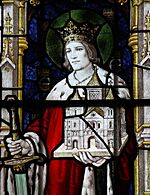
When Roman rule ended around 410 AD, Northern Britain might have been ruled by Romano-British leaders. But the area soon broke into smaller kingdoms. York became the capital of the British kingdom of Ebrauc.
In the late 400s and early 500s, Angles from Germany started settling in the coastal areas. They took over all of East Yorkshire and the British kingdom of Ebruac around 560 AD. The Angles called this land Dewyr, or Deira. Around 600 AD, Æthelfrith united Deira with a northern kingdom, forming Northumbria, with its capital at Eoforwic (modern York). A later ruler, Edwin of Northumbria, conquered the kingdom of Elmet in 617 AD. He became a Christian in 627 AD and was baptized in Eoforwic.
The Viking era began for Northumbria in 793 AD with an attack on a monastery. Danish Vikings came across the North Sea to raid the coast, while Norwegians raided other islands. In 865 AD, a large Viking army landed in England. They took York in 866 AD and eventually conquered all of Northumbria.
The Middle Ages: Danes, Normans, and Wars
After the Danes took over, their leader Guthrum gave land to his followers in 875 AD. Most English people were allowed to keep their land under Danish rule. The Vikings changed the name of York from Eoforwic to Jorvik. They destroyed many early monasteries, but some churches survived. Eventually, the Danish leaders became Christians. It was under the Danes that the ridings and wapentakes (local divisions) of Yorkshire were set up. Jorvik became the main center for trade and government.
Later, in 954 AD, the King of Jorvik was killed, and England took control. However, the influence of the Norse (Vikings) remained strong. Saint Olave's Church in York is a reminder of the Norwegian influence.
In 1066, after King Edward the Confessor died, Yorkshire became the site of two big battles that decided who would be the next king. Harold Godwinson was declared King of England. But Harold Hardrada, King of Norway, and William, Duke of Normandy, also wanted the throne.
In late summer 1066, Harold Hardrada and Tostig Godwinson sailed up the Humber towards York. They defeated the northern English army at the Battle of Fulford. Harold Hardrada then occupied York. King Harold Godwinson marched his army quickly from London to face the invasion. On September 25, 1066, he reached Stamford Bridge and defeated the Norwegian Army. Both Harold Hardrada and Tostig Godwinson were killed. This battle was very important because it was the last time a Scandinavian army seriously threatened England.
Just three days later, on September 28, William Duke of Normandy landed in southern England. Harold Godwinson had to rush his army south from Yorkshire. They met at the Battle of Hastings, where the English army was defeated, and Harold Godwinson was killed. This allowed William to become King of England.
King William I and the Normans didn't immediately control all of England. Rebellions in the north, including Yorkshire, led to the Harrying of the North. This was a harsh campaign where William destroyed land and food supplies in 1069-70. Many people died from hunger or exposure. By 1071, the last rebellion in Yorkshire was stopped. The Norman campaign was so severe that land values in Yorkshire dropped by two-thirds between 1069 and 1086.
In the early years of Norman rule, new rulers built simple castles. Soon, more complex castles called motte and bailey castles were built. The powerful barons appointed by King William built large castles at places like Conisbrough, Pontefract, Richmond, and two in York. A chain of castles was also built across the southern edge of the North York Moors, including Scarborough and Helmsley.
When the Normans arrived, there were no monasteries in Yorkshire. But in the centuries after the Conquest, beautiful abbeys and priories were built. The first was Selby Abbey, founded in 1069. Others included Fountains, Whitby, and Rievaulx. These religious communities grew, especially after Thurstan became the Archbishop of York in 1114.
Norman landowners also wanted to make more money by creating new towns and planned villages. Places like Richmond, Pontefract, Sheffield, and Scarborough were established this way. York was already a major town before the Normans.
The Danish invasions stopped, but the Scots continued to invade throughout the medieval period. The Battle of the Standard was fought against the Scots near Northallerton in 1138.
During this time, most people in Yorkshire were small-scale farmers. Some families started working in crafts, trade, or early industries. By 1300, farmers had reached the highest limits of cultivation in the Pennines. Landowners, both lay and monastic, mined minerals. There were iron forges and lead mines in the northern dales. In the West Riding, many small coal mines existed.
Until the late 1100s, the cloth industry was mainly in cities like York and Beverley. By 1300, other towns like Ripon and Whitby were also making cloth. Around this time, cloth making started to shift to rural communities in the West Riding. Here, it was a "cottage industry" (people made cloth at home) and was free from strict town rules.
Sheffield, with its fast-flowing rivers and hills full of coal, iron ore, and stone for grindstones, was perfect for water-powered industries. Water wheels, first used for grinding corn, were often changed to make blades. As early as the 1300s, Sheffield was known for making knives, as mentioned in Geoffrey Chaucer's The Canterbury Tales.
In the early 1300s, Yorkshire suffered from bad harvests, animal diseases, and Scottish armies raiding. The Black Death arrived in Yorkshire in 1349. These disasters greatly reduced the population, meaning more land became available for those who survived. This led to the rise of wealthier farming families. Large land areas, called Honours, were given to the king's sons to support their royal lives. These sometimes combined to form Duchies, like the Duchies of York and Lancaster.
Wars of the Roses
When conflict broke out between the two Dukes during the Wars of the Roses, much of the fighting happened in Yorkshire. Many leading families in the East and West Ridings supported the House of Lancaster. But in the North Riding, loyalty was split, with some families supporting the House of York.
Yorkshiremen fought in the Hundred Years' War under John of Gaunt, 1st Duke of Lancaster. King Richard III of England from the House of York held an early position in the Council of the North at Middleham Castle.
Early Modern Times
When the Earl of Richmond became King of England in 1485, his dynasty began to reduce local power by taking away religious rights and economic freedoms.
The Yorkshire rebellion of 1489 happened during the reign of Henry VII. The King wanted money to help defend Brittany in a war against France. He sent the Earl of Northumberland to collect taxes. However, many people in Yorkshire and Northumberland said they had already paid enough taxes and didn't want to give more money for a war far away. A rebellion started in April 1489, and the Earl was killed. The King sent a large army, and the rebel leader was hanged. The rebellion showed the King that the North of England was difficult to control.
Between 1536 and 1540, Henry VIII of England closed down all the monasteries in England, an event called the Dissolution of the Monasteries. This had a huge and lasting effect on Yorkshire. Thousands of acres of monastic land were sold, creating new estates for wealthy families and business owners. About 120 religious places were closed in Yorkshire. The unpopularity of the Tudor royals led to events like the Pilgrimage of Grace and Rising of the North.
During the reign of Queen Elizabeth, Yorkshire's population grew steadily. New industries created jobs and wealth. Improved farming and food imports helped prevent shortages. More people meant more pressure to enclose common land for farming, and many farming families turned to cottage industries to earn a living.
The Gunpowder Plot of 1605 had connections to Yorkshire, as Guy Fawkes was born in York. However, an inquiry showed that the plot didn't have much support in the county.
The economy of many West Riding towns became very different in the 1600s. Farmers combined mining, metal working, weaving, and other crafts with agriculture. These towns were not controlled by strict guilds. By 1600, Sheffield was the main center for making cutlery in England. In Leeds, by 1629, manufacturers were employing people full-time to make cloth.
Many local families were Cavaliers (supporters of the King) in the English Civil War. At the start of the war, King Charles tried to set up a base at Kingston upon Hull but was refused entry. After some early wins, the King's forces were defeated across most of Yorkshire. In 1644, at the Battle of Marston Moor, Oliver Cromwell's cavalry defeated Prince Rupert's forces. In the following months, the remaining royalist bases in the north fell. After the war, many old castles in Yorkshire, like Helmsley and Pontefract, were taken apart so they couldn't be used as forts again.
King James II of England was the Duke of York and had connections to colonial New York.
Some locals were secretly Catholic or supported the Jacobite cause (who wanted the Stuart kings back). The national government tried to address their concerns by setting up a Council of the North, but these were later abolished.
Modern Times
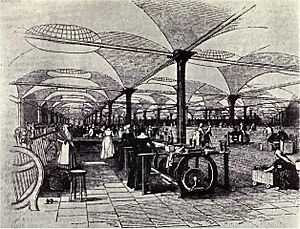
The 1800s were a time of fast growth for cities and industries in Yorkshire. Yorkshire was already a center for textiles, especially in the West Riding. Steel production continued to be strong around Sheffield, as did coal mining. The textile industry quickly adopted new machinery, and by the 1860s, large factories were common.
Steel production involved long hours and dangerous conditions. Friedrich Engels described the tough conditions in Sheffield in his book The Condition of the Working Class in England in 1844. Sheffield became a main center for trade unions. In the 1860s, conflicts between factory owners and workers led to the 'Sheffield Outrages'. The Sheffield Trades Council helped form the Trades Union Congress (TUC) in 1866.
William Wilberforce, a Member of Parliament for Hull, was a famous leader in the movement to end the slave trade.
The Edwardian period in Yorkshire saw the rise of the Labour Party, which pushed for more reforms. Robert Baden-Powell, 1st Baron Baden-Powell, who founded the Scouting movement, commanded the Northern Territorial Army at Richmond Castle until 1910.
Changes in 1974
Local government in England was changed in 1974 by a new law. Under this law, the old divisions of Yorkshire (the Ridings) were abolished. The area of Yorkshire was divided into several new counties:
- Some parts of the historic county were moved to other counties, like Sedbergh and Dent going to Cumbria, and Slaidburn going to Lancashire.
- Middlesbrough and Redcar were moved from the North Riding to Cleveland, but later returned to Yorkshire in 1996 as part of North Yorkshire.
- Most of the East Riding was moved to Humberside, but later became the new East Riding of Yorkshire in 1996.
- The remaining parts of the East Riding and North Riding, along with the city of York and northern/eastern parts of the West Riding, became North Yorkshire.
- The rest of the West Riding became the new metropolitan counties of South Yorkshire and West Yorkshire.
See also


